
The Poeciliidae are a family of freshwater fishes of the order Cyprinodontiformes, the tooth-carps, and include well-known live-bearing aquarium fish, such as the guppy, molly, platy, and swordtail. The original distribution of the family was the Southeastern United States to north of Río de la Plata, Argentina, and Africa, including Madagascar. Due to release of aquarium specimens and the widespread use of species of the genera Poecilia and Gambusia for mosquito control, though, poeciliids can today be found in all tropical and subtropical areas of the world. In addition, Poecilia and Gambusia specimens have been identified in hot springs pools as far north as Banff, Alberta.

Peripatus is a genus of velvet worms in the Peripatidae family. The name "peripatus" is also used to refer to the Onychophora as a whole, although this group comprises many other genera besides Peripatus. The genus Peripatus is found in Central America, the Caribbean and northern South America.
Sir Everard Ferdinand im Thurn was an author, explorer, botanist, photographer and British colonial administrator. He was Governor of Fiji in the years 1904–1910.

Acacia, commonly known as the wattles or acacias, is a large genus of shrubs and trees in the subfamily Mimosoideae of the pea family Fabaceae. Initially, it comprised a group of plant species native to Angola and Australasia. The genus name is New Latin, borrowed from the Greek ἀκακία, a term used by Dioscorides for a preparation extracted from the leaves and fruit pods of Vachellia nilotica, the original type of the genus. In his Pinax (1623), Gaspard Bauhin mentioned the Greek ἀκακία from Dioscorides as the origin of the Latin name.
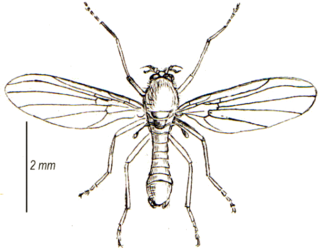
Thaumaleidae, the solitary midges or trickle midges, are a group of nematoceran flies related to the Ceratopogonidae, Chironomidae, and the Simuliidae. They are small, stocky, yellow to brown flies (3–4 mm). Very few species are known for this family. Larvae are found in films on rocks and the nonfeeding adults are usually found on foliage along the same streams in which the larvae are found. A few solitary midges are found in the Southern Hemisphere, but Thaumaleidae are generally an Holarctic family.

The Streblidae are a family of flies in the superfamily Hippoboscoidea, and together with their relatives the Nycteribiidae, are known as bat flies. They are winged or wingless ectoparasites of bats, and often have long legs. They appear to be host-specific, with different species of bat flies occurring only on particular species of bat hosts, sometimes with multiple species of flies sharing a host bat.

Notothenioidei is one of 19 suborders of the order Perciformes. The group is found mainly in Antarctic and Subantarctic waters, with some species ranging north to southern Australia and southern South America. Notothenioids constitute approximately 90% of the fish biomass in the continental shelf waters surrounding Antarctica.

The Chamaemyiidae are a small family of acalyptrate flies with less than 200 species described worldwide. The larvae of these small flies are active and predatory and are often used for biological control of aphids, scale insects, and similar pests. Chamaemyiid fossils are poorly represented in amber deposits, but a few examples are known from the Eocene epoch onwards.

The Raphidophyceae are a small group of eukaryotic algae that includes both marine and freshwater species. All raphidophytes are unicellular, with large cells, but no cell walls. Raphidophytes possess a pair of flagella, organised such that both originate from the same invagination. One flagellum points forwards, and is covered in hair-like mastigonemes, while the other points backwards across the cell surface, lying within a ventral groove. Raphidophytes contain numerous ellipsoid chloroplasts, which contain chlorophylls a, c1 and c2. They also make use of accessory pigments including β-carotene and diadinoxanthin. Unlike other heterokontophytes, raphidophytes do not possess the photoreceptive organelle typical of this group.

The Palaeonisciformes are an extinct order of early ray-finned fishes (Actinopterygii) which began in the Late Silurian and ended in the Late Cretaceous. The name of the order is derived from the Greek words paleo (ancient) and ὀνίσκος, probably pertaining to the organization of the fishes' scales, similar to the exoskeletal plating of woodlice.
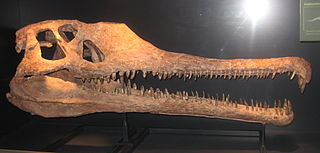
Angistorhinus is an extinct genus of phytosaur known from the Late Triassic period of Texas and Wyoming, United States. It was first named by Mehl in 1913 and the type species is Angistorhinus grandis. Other species from Texas and Wyoming, A. alticephalus, A. gracilis and A. maximus, are cospecific with the type species. Angistorhinus is known from the holotype UC 631, partial skull and lower jaws recovered from the Popo Agie Formation, Chugwater Group, Wyoming and from the associated paratype UM 531, a partial skull, TMM 31098-1, skull and lower jaws and ROM 7977, partial skull and lower jaws, recovered from the 'Pre-Tecovas Horizon' in the Dockum Group, Texas. A possible second species, A. talainti is known from the Triassic of Morocco. In 1995, Long and Murry created the new combination, Angistorhinus megalodon by synonymy for Brachysuchus. Hungerbühler and Sues (2001) hypothesised that Angistorhinus is a junior synonym of Rutiodon. However, in 2010 Michelle R. Stocker retained the validity of Brachysuchus and of A. grandis.
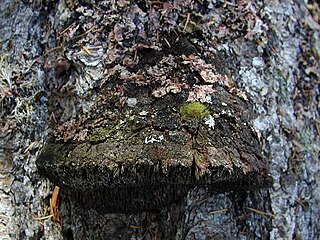
Echinodontium is a genus of fungi in the family Echinodontiaceae. The genus was published by American mycologist Job Bicknell Ellis in 1900, who described it thus: "Differs from Hydnum in the thick, woody pileus of Fomes and the teeth beset with spines, as in Mucronophorus and Hymenochaete". The type species, Echinodontium tinctorium, is commonly known as the "indian paint fungus" owing to its traditional use for bodypainting.
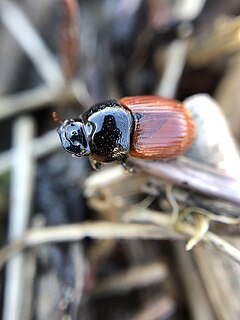
Aphodius is a genus of beetles in the family Scarabaeidae. In most species both the adults and larvae are coprophagous although some species have herbivorous or saprophagous larvae. Aphodius species typically dominate dung beetle communities in north temperate ecosystems. Most species are functionally classified as endocoprids, also known as dwellers, because the larvae live and feed within the dung pat itself.
Howard James Banker was an American mycologist. He received his PhD from Columbia University in 1908. Banker was an associate editor of the journal Mycologia starting from its establishment in 1909, until it became the official publication of the Mycological Society of America in 1933. He published several papers in the journal, including a revision of the North American Hydnaceae, which discussed 62 species in 10 genera. Banker died at his home in Huntington, New York, in 1940. The genus Bankera is named after him.

Hydnellum geogenium is a species of tooth fungus in the family Bankeraceae. It was described as new to science in 1852 by Elias Magnus Fries. Howard James Banker transferred it to the genus Hydnellum in 1913. The fungus is found in Europe and North America, where it grows in coniferous woods. It is inedible. H. geogenium is considered endangered in Switzerland. Fruitbodies of the fungus contain a yellow pigment compound called geogenin.
Ellobiopsis is a genus of unicellular, ectoparasitic eukaryotes causing disease in crustaceans. This genus is widespread and has been found infecting copepods from both marine and freshwater ecosystems. parasitism has been seen to interfere with fertility in both sexes of copepods.
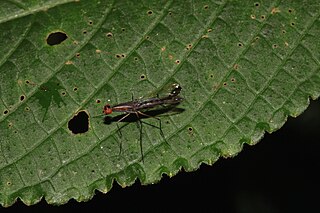
The family Nothybidae contains only the genus Nothybus, a group of colorful and elongated flies. The family has been recently revised.
Hydnellum rickeri is a tooth fungus in the family Bankeraceae. Found in North America, it was described as new to science in 1913 by mycologist Howard James Banker from collections made in Orono, Maine. It is named after botanist Percy L. Ricker, who collected the type specimen. Fruit bodies are dingy brown to olive-colored, and have a strong, spicy odor that persists after they have dried.
Sarcodon roseolus is a species of tooth fungus in the family Bankeraceae. Found in North America, it was described as new to science in 1913 by mycologist Howard James Banker, who collected the type specimens in North Carolina.

Pyrenomonadaceae is a family of cryptomonads which includes three or four known genera. They are distinguished from other cryptomonads by their nucleomorphs being imbedded into the pyrenoid, and the presence of distinctive pigment phycoerythrin 545.















